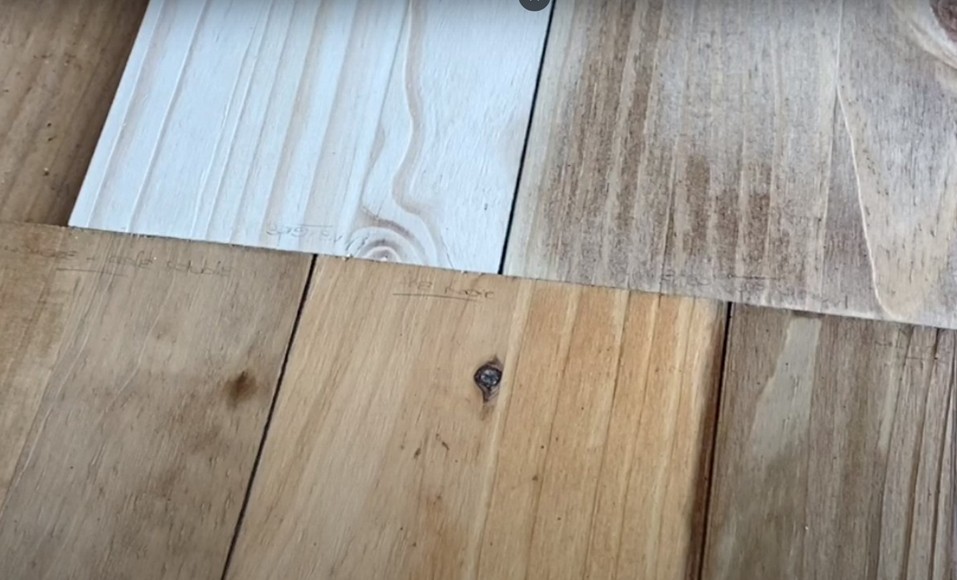How to stain wood is a process that requires care and precision. In this article, we'll explain the various stages for an even, long-lasting result. Whether you want to stain a piece of furniture or carry out a DIY project, we'll give you practical advice for a successful stain. Discover our tips and techniques for sublimating wood with the stain of your choice!
The wood staining technique: a simple, elegant process
Wood staining is a simple and elegant process. The use of stain gives wood a new color while preserving its natural texture.
The first stage is to prepare the wood by carefully sanding it to remove all imperfections. This will enable the stain to apply evenly and adhere properly.
ThenIn order to achieve the best possible finish, we recommend applying a base coat before staining. This step seals the wood and ensures better adhesion of the stain.
Once the primer coat is dryYou can apply the stain with a brush or cloth. It's important to follow the manufacturer's instructions for best results.
After applying the dyeIf you are using a wood stain, allow the wood to dry for the time indicated by the manufacturer. This will allow the stain to penetrate deep into the wood, giving it a long-lasting color.
FinallyIf you wish, you can apply a top coat to protect the stain and give your wood its final appearance. This can be a varnish, oil or wax, depending on your preference.
It is important to note that staining can vary according to the type of wood used and the desired color. It is therefore advisable to test wood samples before staining the complete piece.
All in all, the wood staining technique is a simple, elegant process that gives new life to your furniture or wooden objects. Use it to express your creativity and add a personal touch to your interior.
Making MODERN wooden furniture with BLEACH
[arve url="https://www.youtube.com/embed/NOMoYTBIcaQ "/]
How to stain wood naturally?
To stain wood naturallyThere are several methods that use natural ingredients. Here are some of the most common options:
1. Coffee or tea : Prepare a strong infusion of coffee or tea and leave to cool. Apply this infusion to the wood with a brush or clean cloth. Repeat the application until the desired color is achieved. Allow to dry between coats.
2. Vinegar and steel : This mixture reacts with the natural tannin in the wood to stain it. You can prepare this mixture by soaking pieces of iron or steel in white vinegar for a few days. Apply the mixture to the wood with a brush. The color will gradually oxidize on contact with air.
3. Fruit or vegetable juices : Some fruit and vegetable juices can also be used to stain wood. For example, beet juice can give a red tint, carrot juice an orange tint and blueberry juice a bluish tint. Simply apply the juice to the wood with a brush or cloth.
4. Walnut shells : Walnut shells can be used to stain wood black. Boil walnut shells in water for about an hour, then filter the liquid. Apply this natural colorant to the wood with a brush or cloth.
It is important to note that these natural dyeing methods may require several applications to obtain the desired color.. What's more, they are not as predictable as commercial stains. It is therefore advisable to test wood samples before staining a complete project.
Which product for staining wood?
What product should I use to stain wood?
When it comes to staining wood, there are several product options available on the market. However, choosing the right product will depend on your aesthetic preferences and the wood's intended use.
1. Water-based dyes : These stains are easy to use and quick-drying. They are also environmentally friendly, as they contain no harmful solvents. Water-based stains are ideal for indoor projects, but may require an additional protective layer for outdoor use.
2. Oil-based dyes : Oil-based stains offer a deeper, richer finish than water-based stains. They are often used for furniture and outdoor projects. Oil-based stains take longer to dry and can give off strong odors, so it's important to ventilate the work area.
3. Gel-based dyes : Gel-based stains offer a thick finish and can be applied to vertical surfaces without running. They are particularly suitable for porous woods such as oak. Gel-based stains often require a sanding step between coats to achieve a smooth result.
Whatever stain you choose, it's important to prepare the wood properly by sanding to remove irregularities and residues. It is also advisable to apply a coat of varnish or lacquer after staining to protect and extend the life of the wood.
Remember to always follow the manufacturer's instructions for application and drying time.
How do I apply stain to wood?
To apply stain to wood, follow these steps:
1. Prepare the wood surface by sanding lightly with fine sandpaper to remove irregularities and open up the wood pores.
2. Carefully dust the surface with a clean, dry cloth to remove all traces of dust.
3. Use a natural bristle brush or sponge to apply the stain to the wood. Be sure to apply an even coat, following the grain of the wood for an aesthetically pleasing result.
4. Allow the first coat of stain to dry for the time recommended by the manufacturer. This usually takes a few hours.
5. If you wish to achieve a more intense color, you can apply a second coat of stain after the first coat has dried completely.
6. Once the stain is completely dry, you can apply a protective topcoat, such as a varnish or wax. This will protect the stain and give the wood a beautiful finish.
7. Allow finish coat to dry according to manufacturer's instructions before using or handling treated wood.
Remember to wear gloves and work in a well-ventilated area when applying stain to wood. Also follow the specific instructions provided by the manufacturer of the stain you're using.
How to stain raw wood?
How to stain raw wood?
There are several methods for staining raw wood and giving it an attractive finish.
1. Dyeing : Use a wood stain to obtain different colors on your wood. Make sure you choose the right stain for the type of wood you're using. Apply the stain with a brush or sponge, following the grain of the wood. Allow to dry completely before applying a top coat.
2. The paint : If you want an opaque color on your wood, you can opt for paint. Before painting, lightly sand the wood surface for better adhesion. Apply a coat of undercoat to seal the wood, then apply the paint according to the manufacturer's instructions. You can also use stencils or painting techniques to achieve specific patterns.
3. Varnish : Varnish is another option for coloring raw wood while preserving its natural appearance. Choose a varnish suited to the type of wood you're using, whether gloss, matte or satin. Apply several coats of varnish with a brush or cloth, following the grain of the wood. Each coat should be lightly sanded before applying the next to achieve a smooth finish.
4. Natural products : Some people prefer to use natural products to color their raw wood. For example, caffeine can give a dark brown hue, while vinegar and steel can give a gray tint. Experiment with different natural ingredients to achieve the desired color.
Remember to take appropriate safety precautions when using chemicals, and to follow the manufacturer's instructions.
What types of wood can be stained?
The types of wood that can be stained are mainly those with a porous structure, such as oak, ash and pine. However, it's important to note that some hardwoods, such as maple and birch, can also be successfully stained. We recommend the use of specific wood stains for optimal, long-lasting results.
What's the difference between water-based and oil-based dyes?
The difference between water dyeing and oil dyeing lies in the means used to dilute the pigments. Water dyeing uses water as a solvent, making it more environmentally friendly and easier to clean. It is often used for interior projects such as wall painting or furniture decoration. Oil dyeingThe use of oils (such as linseed oil) as solvents makes it more durable and slower-drying. It is commonly used for artistic painting and requires specific solvents for cleaning.
How to prepare wood properly before staining?
To properly prepare wood before staining, it's essential to follow a few important steps. First, make sure the wood is clean and free of any dirt or dust. Next, lightly sand the surface to remove imperfections and allow the stain to adhere better. It's also important to apply a sealant to protect the wood against humidity. Finally, it is advisable to test a small area of the wood to ensure the final look before proceeding with the full stain.
What tools do I need to stain wood?
The tools needed to stain wood are : a special brush to apply the stain, sandpaper to prepare the wood surface, a clean cloth to wipe off excess stain and gloves to protect your hands.
How do I apply the dye evenly?
To apply the stain evenly, it's important to follow these key steps:
1. Prepare the surface by removing dirt and sanding lightly if necessary.
2. Protect your hands with gloves and wear appropriate clothing to avoid staining.
3. Mix the tincture well before applying.
4. Use a brush or sponge to spread the stain evenly, following the wood grain if necessary.
5. Be careful not to apply too much dye at once, to avoid drips and stains.
6. Wipe off any excess stain with a clean, dry cloth.
7. Allow to dry completely according to manufacturer's instructions.
8. Repeat if a second coat is required to achieve the desired color.
9. Last but not least, clean your tools thoroughly after use.
By following these tips, you'll be able to apply your dye evenly and achieve a professional result.
How long should the dye be left to dry before finishing?
Allow the dye to dry for about 24 hours before finishing it.
How do I care for and protect stained wood?
To maintain and protect stained wood, it's important to regularly apply a coat of varnish or woodstain specifically designed for wood. This helps prevent damage caused by humidity, UV rays and stains. It's also advisable to clean wood with a mild product and lukewarm water, avoiding aggressive chemicals that could damage the color. Finally, avoid placing hot or pointed objects directly on the wood surface, to prevent scratching or warping.
Can I mix different shades to create a custom color?
Yes, it is possible to mix different shades to get a custom color.
Are there eco-friendly or non-toxic stains for wood?
Yes, there are ecological or non-toxic stains for wood. These products are made from natural, environmentally-friendly ingredients such as plant extracts and organic pigments. They contain no substances harmful to health or the ecosystem. These stains offer a more sustainable and responsible alternative to the traditional products used to stain wood.
What are the common mistakes to avoid when staining wood?
Common mistakes to avoid when staining wood are excessive application of dyeswhich can lead to staining or uneven color, as well as lack of wood preparation before applying the stain, which can lead to poor adhesion and an uneven finish. It is also important to avoid irregular brush or cloth movementsThis can leave visible marks on the wood. Finally, it is essential to respect recommended drying times for each coat of stain applied.
In conclusion, staining wood is a great way to give it a new look and protect it from the elements. Whether it's for furniture, flooring or any other wood surface, staining is a versatile option that offers many possibilities for personalization.
It's important to prepare properly by cleaning and sanding the surface before applying the stain. It is then advisable to apply several coats of stain to obtain a deeper, more uniform color.
Using HTML tags in this text highlights the key points to remember when it comes to staining wood. Careful preparation, the use of several coats of stain and regular maintenance are important aspects to take into account to achieve a satisfactory result.
In short, staining wood can be a rewarding activity that brings your interior design projects to life. Take your time, follow the recommended steps and give free rein to your creativity to transform your wooden surfaces into true works of art.








